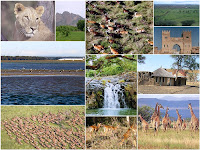Boma National Park South Sudan
 |
| Boma Jonglei - Google Map |
The Boma-Jonglei landscape encompasses Boma and Badingilo National Parks, broad pasturelands and floodplains, the vast swamps and internationally recognized wetlands of the Sudd, including the Zeraf Game Reserve and the proposed Loelle protected area. The landscape covers parts of Jonglei, Eastern Equatoria, and Central Equatoria states, supporting an abundance of wildlife species, including elephants, giraffe, elands, oryx, lions, wild dog, buffalo, and the endemic, endangered antelope species Nile Lechwe. Sudan Tribune
Boma Jonglei
- This 77,220-square-mile landscape is about the size of New York State.
- Around 1.3 million antelopes migrate across the Boma-Jonglei Landscape taking advantage of seasonal changes in water and food supplies.
- Among the world's most important bird areas, the Sudd Swamp is a stopover site for birds migrating between Africa and Eurasia. Wildlife Conservation Society
 |
| Boma National Park |
Before Southern Sudan descended into civil war in 1983, the country's protected areas supported some of the most spectacular and important wildlife populations in Africa, and hosted the second largest wildlife migration in the world. Surveys in the preceding years revealed that Boma National Park, west of the Ethiopian border, as well as the Sudd wetland and Southern National Park near the border with Congo, provided habitat for large populations of kob and topis (two types of antelope), buffalo, elephants, giraffes, hartebeests (another antelope), and lions. Sudan's forest reserves also provided habitat for bongo (also an antelope), giant forest hogs, red river hogs, forest elephants, chimpanzees, and forest monkeys. WCS
Boma National Park (2,280,000 ha) was established in 1977 but has not been gazetted. The Anyuak, Murle and Toposa peoples are the principal inhabitants of the area. The Anyuak and Murle traditionally hunt during the dry season while the Toposa hunt during the rains. Sustainable traditional hunting practices have, however, now been disrupted with the introduction of firearms resulting in increased hunting pressure. A further threat is the presence of large numbers of cattle in the park, creating conflict with game for water and grazing during the dry season and also resulting in overgrazing. Birdlife
 |
| Boma National Park |
More than a million animals — including elephants, buffaloes, ostriches, lions, giraffes and a rare type of stork — have been unexpectedly seen living and migrating across Southern Sudan, where no surveys of wildlife had been conducted for the past 25 years due to civil war in the region.Sudan - both Sudans - such beautiful and wonderful countries. With abundant, vast resources. Enough. Their people have had enough. Enough of uncertainty instability, insecurity and wars. It is time, that these two of the poorest countries in Africa and yet very rich with resources, to stop fighting; and stop focusing only on oil. South and North Sudan have extensive and enormous natural resources. It is time their politicians and leaders put petty differences aside and do the needed and whatever it takes; and invest in making their people develop and secure. It is time they allow their people to have normal lives. And let their wildlife and habitats BE.
Decades of war wrought significant damage to the region, along with excessive hunting, desertification of the land and periodic droughts, so wildlife numbers were declining in the stricken country. Based on observations in other war-torn nations, conservationists thought the wildlife in Southern Sudan would be wiped out, but it wasn't.
With insecurity and instability, poor infrastructure, many armed militias and tribesmen around the park - Boma National Park needs much better planning and management to thrive. It needs much more investments in protecting wildlife and their habitats; and in the tourism industry - financial, material, much better infrastructure and many more, well trained personnel, to both protect its wildlife and to serve in the tourist industry. All unlicensed firearms in the country, especially in Jonglei and Eqauatria, should be collected. Poaching should be stopped. And above all: to benefit and profit from what remains of its wildlife and other natural resources, South Sudan needs security and stability.
+ The Sudan Tribune
+ See photos of Boma by: Miguel Juárez Lugo
+ National Geographic: South Sudan Guide
+ South Sudan: Fauna and Flora
+ World Travel Guide: South Sudan
+ Lonely Planet: South Sudan Guide
+ Wiki Travel: South Sudan Guide
+ Trip Advisor: South Sudan Travel Guide
+ NPR: South Sudan Battles Poaching In Quest For Tourism
+ Images: Google



